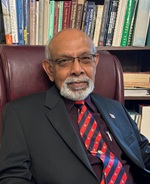INVITED SPEAKER IN ICCEA 2025

Prof. Ken S. Sivakumaran, McMaster University, Canada
Prof. Ken Sivakumaran is currently a Professor Emeritus at the Department of Civil Engineering, McMaster University, Canada. He obtained his Ph.D. in Solid Mechanics (Civil Engineering) from the University of Calgary, Alberta, Canada. He supervised several graduate students and published over 150 journal and conference papers in the area of steel structures in general, and cold-formed steel structures in particular. He is a member of Canadian Technical Committee on Cold Formed Steel Structural Members- CSA-S136 and he is a member of several committees of the American- AISI-North American Cold-Formed Steel Specification. He had been in the editorial boards of several international journals, including Canadian Journal of Civil Engineering, Steel and Composite Structures, An International Journal, etc.
Speech Title: Effect of flange fastener holes on strength and rotational capacity of steel i-beams
Abstract: Bolted moment connections of steel frames require flange holes which may compromise the strength and the rotational capacity of the beam ends. The objectives of the research program were: (i) to investigate the effects of flange holes and flange fastener holes on the strength and rotation capacity of steel I-beams made of ASTM A992 steel, and (ii) to assess the validity of exemption rules currently provided in international codes for moment connections having flange holes. This paper presents an experimental investigation, involving twenty-five steel beam specimens, on the effects of flange holes on the flexural behaviour of steel I-beams. Circular holes of various diameters (0% to 48% of the gross flange area) are under consideration. The four test groups are: (1) tests with solid flanges, (2) tests with holes in tension flanges only, (3) specimens with holes in both tension and compression flanges, and (4) beams with flange holes in both flanges but with fasteners placed in these holes. The experiments reveal that the beam specimens having the AfnFu/AfgFy ≥ 1.0 were able to reach the gross-section plastic moment and exhibit substantial inelastic rotation capacity (Ry of more than 9). If AfnFu/AfgFy <1.0 then the beam specimens failed primarily due to a rupture of tension flange through the flange holes which substantially reduced the inelastic deformation capacity. This research study recommends a design approach analogous to the axial tension member provisions. The comparison of the proposed design procedure with the corresponding international code provisions reveals that the current code provision is unnecessarily conservative for steel grades such as A992 steel. On the other hand, the current code provision may not be adequate for higher strength steels such as HSLA 80 steel, ASTM A913 Gr: 60 and HPS-485W having the minimum yield-to-ultimate strength ratio of more than 0.85.

Prof. Atef Badr, Department of Civil Engineering & Quantity Surveying, The Military Technological College, Muscat, Oman
Professor Atef Badr is a resolute academic leader with a strong record of academic, industrial and management experience across the globe, including UK, Egypt, Oman, Saudi Arabia, and Kazakhstan. He is a Chartered Manager, a Chartered Civil Engineer (CEng) and a Fellow of the Institution of Civil Engineers (FICE) with expertise in construction materials, structures, concrete technology, water engineering, renewable energy, and sustainable construction. His research on concrete technology was acknowledged by the Institution of Concrete Technology (ICT) and, therefore, he has been honored with its fellowship (FICT), in 2017. Professor Badr is a regular Invited/Keynote Speaker in international conferences including, The Concrete Solutions series (International Conference on Concrete Repair), Neville Symposium on Advances in Concrete Technology, and Arab Engineering Conference. Professor Badr is the Chairman of the ICSBC series (International Conference on Sustainable Buildings and Construction) and the Editor in Chief of the proceedings of its three editions. The first was the 2017 International conference on Cement and Concrete Technology “Concrete for the Modern Age: Developments in Materials and Processes”, published by Whittles publishing, Scotland, UK. The second was in 2021 on the Water Engineering and Management of Water Resources “Towards a Sustainable Water Future”, published by Tomas Telford, Institution of Civil Engineers (ICE), UK. This year he is chairing the ICSBC2025 “Towards a Sustainable Construction – Building the Future”.
Speech Title: The Role of the Construction Industry in Global Development, Social Security and Adapting to Climate Change
Abstract: The construction industry is a vital sector contributing significantly to the economic growth, social security, and national prosperity, particularly in developing countries. In addition, the construction industry provides the world population with accommodations, comfortable living spaces, workplaces, facilities for everyday activity, infrastructure, educational institutions, and healthcare establishments. Thus, protecting their health and wellbeing. Unfortunately, these desirable economic and social benefits are often eclipsed by its impact on the environment. The adverse impact of the construction processes on the environment is widely acknowledged, although in many cases the adverse impact is related to the operation of the facility or buildings after the completion of the construction. This paper aims to provide a balanced perspective of the construction industry and address the role of the construction industry in global development, social security and adapting to climate change. At one hand, the contributions of the construction industry to the economic growth and social security were demonstrated by quantifying the contribution to the gross domestic product (GDP) and the employment within the sector. On the other hand, the paper provided critical appraisal of the adverse effect of the construction industry on the environment. Finally, the paper highlighted the importance of sustainable construction as a driving force for a greener future and helping all countries in meeting their obligation to reduce the emission of greenhouse gases (GHG) and adapting to climate change, in compliance with, legally binding, Paris Agreement on climate change.

Assoc. Prof. Lapyote Prasittisopin, Chulalongkorn University, Thailand
Dr. Lapyote Prasittisopin is Director of Center of Excellent on Green Tech in Architecture, Chulalongkorn University and Associate Professor in Department of Materials Science, Faculty of Science, Chulalongkorn University. He received his MS degree in Material Science (Polymer) and his PhD in Civil Engineering (Structural Material) from Oregon State University, USA as well as B.Eng. Chemical Engineering from Chulalongkorn University and LL. B. Law from Sukhothai Thammathirat University. He was former a researcher at Siam Cement Group, Thailand and O.H. Hinsdale Wave Research Laboratory, USA to launch several structural products. He has published 14 patents and more than 100 academic articles. His research interests include Architecture Engineering, Digital Construction, Building Materials, Sustainability, and Circular Design.
Speech Title: ARCHITECTURE 5.0: Bridging the Human-Centric Gap in Industry 5.0 for Sustainable and Resilient Innovation in the Architecture, Engineering, and Construction Sector
Abstract: As the Architecture, Engineering, and Construction (AEC) sector evolves with technologies from Industry 4.0—such as Building Information Modeling (BIM), robotics, the Internet of Things (IoT), and big data—there is growing interest in transitioning toward Industry 5.0, also called as "Architecture 5.0", which emphasizes human-centricity, sustainability, and resilient innovation aligned with the United Nations Sustainable Development Goals (UN SDGs). However, the application of Architecture 5.0 within AEC sector remains very limited, particularly in addressing human-centered approaches. This review and thematic analysis determined 140 peer-reviewed articles from the Scopus database to assess current research trends and identify gaps. The analysis reveals that energy efficiency (38 occurrences), urban design (30), and project management (21) dominate the discourse, while critical areas such as decision-making (15), air quality (11), sensor integration (7), and deep learning (7) are significantly underrepresented. These findings present an imbalance in research efforts, suggesting the need for expanded focus on technologies and strategies that prioritize human well-being, real-time feedback, and adaptive resilience. This paper offers a conceptual framework and actionable recommendations of Architecture 5.0 for policymakers, planners, designers, and other stakeholders to guide the AEC sector toward a more human-centric, sustainable, and resilient future.

Assoc. Prof. Sungjoo Hwang, Ewha Womans University, South Korea
Dr. Sungjoo Hwang is an associate professor in the Department of Architectural & Urban Systems Engineering at Ewha Womans University. His research centers on the application of information and communication technologies (ICT) to urban systems and infrastructure management, with a particular focus on urban safety, environmental comfort, quality of life, and disaster risk reduction. He leads the Urban Informatics and Intelligent Infrastructure Lab, where his team develops ICT-based solutions—such as wearable sensing, computer vision, machine learning, and geospatial data analytics—to enhance everyday urban experiences. His interdisciplinary work spans smart city systems, emergency response modeling, and AI-enabled monitoring of the built environment. By bridging architectural engineering, urban systems design, and data-driven technologies, Dr. Hwang seeks to advance the development of responsive, inclusive, and resilient cities that improve the lives of their residents.
Speech Title: Vision AI for Assessing Pedestrian Path Quality: Integrating Environmental Perception, Safety, and Accessibility
Abstract: Ensuring safe, comfortable, and accessible pedestrian environments is essential for promoting urban well-being and resilience. This study proposes an integrated AI-based framework for assessing pedestrian path quality, combining analyses of environmental perception, walking safety, and physical accessibility. First, environmental pleasantness is evaluated through component-based analysis of streetscape images using computer vision and machine learning models, which not only detect the presence of visual elements such as greenery and pavement but also infer their qualitative characteristics—such as density, continuity, and maintenance conditions—that influence perceived comfort in the walking environment. Second, walking barriers are detected by identifying abnormal pedestrian gait patterns through OpenPose-based keypoint tracking and LSTM autoencoder models applied to urban CCTV video data, enabling real-time safety monitoring. Lastly, physical accessibility is assessed by estimating road widths using GIS-based road polygon data and morphological image processing, complemented by 3D object detection of obstacles such as illegally parked vehicles to extract effective road widths and evaluate the mobility of disaster response vehicles in narrow alleys. This integrated approach offers an automated solution for monitoring, assessing, and improving the quality of pedestrian infrastructure in terms of comfort, safety, and accessibility, thereby supporting data-driven interventions in high-risk or underserved urban areas.